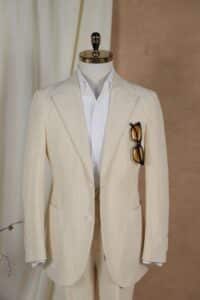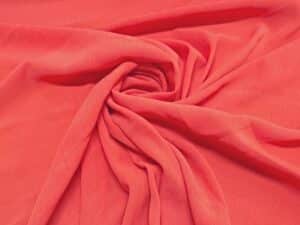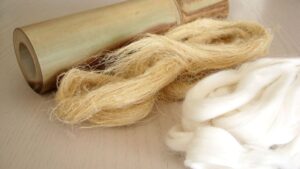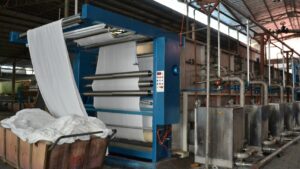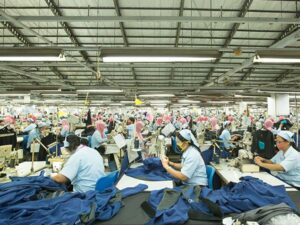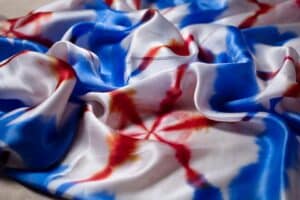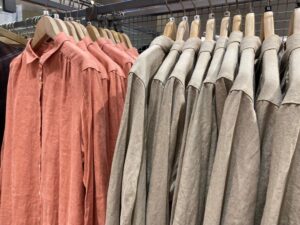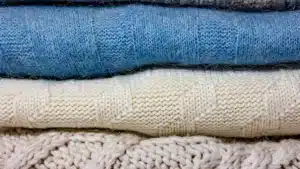
Poplin fabric is known for its smooth and strong texture. It has fine horizontal lines that make it durable. Good poplin usually has 144 warp threads and 72 weft threads per inch. This tight weave makes it very strong. Its softness and shiny look add to its worth. Poplin is great for clothes and home items.
In Chinese, we call Poplin as 府绸(Fǔ Chóu).
Key Takeaways
Poplin fabric feels smooth, is strong, and lets air through. It’s great for summer clothes and home items.
Pick the right type: cotton poplin is soft and airy. Polyester poplin is tough and resists stains.
Take care of it by hand washing and air drying. This keeps poplin colorful and lasting longer.
Properties of Poplin Fabric
Texture and Smoothness
Poplin fabric is smooth and has a neat texture. It has tiny horizontal lines that give it a shiny look. These lines come from weaving threads tightly together. In the past, poplin was made with silk and wool threads. Today, it’s made with cotton, polyester, rayon, or blends. These materials keep it soft and versatile.
Cotton poplin is soft and light, making it great for clothes. It feels nice on the skin, perfect for shirts and dresses. Its smooth surface makes ironing easy, keeping clothes neat. Both cotton and polyester poplin resist wrinkles and stay polished.
Strength and Durability
Poplin fabric is strong and lasts a long time. Its tight weave helps it handle daily use without damage. Cotton poplin mixes cotton’s strength with a sturdy weave. This makes it good for uniforms, workwear, and furniture covers.
Poplin cotton stays strong even after many washes. It’s lightweight but tough, ideal for casual and formal wear. Polyester poplin is even tougher, resisting stretching and shrinking. Whether for clothes or home items, poplin is both strong and useful.
Breathability and Comfort
Poplin fabric is breathable and doesn’t trap heat. Air moves through it easily, keeping you cool. Cotton poplin is especially good at absorbing sweat and staying dry.
Poplin works well in all weather. It’s soft and comfy for all-day wear. Whether it’s a shirt or bed sheets, poplin keeps you comfortable. Its lightness makes it easy to layer for style and function.
How Poplin Fabric is Made
Materials Used in Poplin
Poplin fabric is made from different materials. In the past, silk and wool were used. Today, cotton is the most common material. Blends of polyester and cotton are also popular. These blends usually have a 65/35 or 80/20 ratio. This mix makes the fabric strong, smooth, and comfy.
Poly poplin is another type made with polyester fibers. It is light and strong, perfect for clothes and furniture covers. Some makers use rayon or other synthetic blends. These give poplin special textures and finishes. The material choice depends on how the fabric will be used, like for clothes or home items.
Weaving Process of Poplin Fabric
The weaving process gives poplin its unique look. It uses a plain weave where threads cross tightly. This creates a smooth surface with tiny ribs. The tight weave makes the fabric strong and soft.
Poplin is medium-weight with fine horizontal lines. The weft threads are thicker than the warp threads. This makes the fabric light but durable. The tight weave also helps it resist wrinkles, making it easy to use daily.
Poplin is made using both old and new methods. This helps it stay useful for fashion and everyday needs. Knowing how poplin is made shows why it’s loved for many uses.
Advantages and Disadvantages of Poplin

Benefits of Poplin Fabric
Poplin has many good qualities for clothes and home items. It is light and lets air pass through, great for summer. Poplin shirts and dresses keep you cool on hot days. The fabric absorbs sweat, keeping your skin dry and comfy.
Poplin is strong and lasts a long time, even with washing. Cotton poplin or cotton-poly blends stay tough over time. Its smooth surface doesn’t wrinkle much, so clothes look neat easily.
Poplin has a soft shine that looks fancy. This makes it good for casual and dressy events. Stretch poplin adds flexibility, making it comfy for fitted clothes or activewear. These features show why poplin is useful for many things.
Drawbacks of Poplin Fabric
Poplin has some downsides despite its many good points. Its tight weave makes it strong but less stretchy. This can be a problem for clothes needing more flexibility unless stretch poplin is used.
Poplin is light, which is great for summer but not for winter. You might need to wear layers to stay warm in cold weather. Pure cotton poplin can shrink a little after washing if not treated first.
Even though poplin resists wrinkles, it might need ironing sometimes. These small issues don’t take away from poplin’s overall usefulness and versatility.
Uses of Poplin Fabric
Clothing Applications
Poplin fabric is great for making clothes. It’s light and comfy, perfect for summer. Poplin is often used in shirts, dresses, and skirts. Cotton poplin feels soft, ideal for casual or formal outfits.

For workwear, poplin is strong and looks professional. Uniforms made from poplin stay neat all day. Its smooth surface and slight shine give a polished look. Stretch poplin adds flexibility, great for fitted clothes and activewear.
Poplin is also used in underwear because it’s soft and breathable. It keeps you comfy and lasts a long time. Whether for casual outings or formal events, poplin offers style and usefulness.
Home Textiles
Poplin fabric works well for home items. It’s durable and easy to care for, perfect for curtains, tablecloths, and cushion covers. Poly poplin resists stains and wrinkles, keeping your home tidy with little effort.
Many people like low-maintenance fabrics for their homes. About 68% of buyers pick poly poplin for its ease. Poplin curtains hang nicely and keep their shape over time. Tablecloths made from poplin are elegant and simple to clean, great for daily use or special events.
Poplin is also used for bedding. Cotton poplin sheets and pillowcases are soft and breathable, giving you a comfy sleep. It keeps colors bright even after many washes, making it great for home decor.
Other Practical Uses
Poplin fabric is useful in many industries. It’s strong and resists wear, good for protective workwear like lab coats and coveralls. In healthcare, poly poplin is valued for being antimicrobial and easy to clean.
The car industry uses poly poplin for lightweight upholstery in electric cars. It’s durable and keeps colors well, making it practical. Poplin is also used in smart textiles for wearable tech because it’s versatile and strong.
Poplin is popular in advertising too. Banners and displays made from poly poplin are light and easy to carry. The fabric holds bright colors, making designs stand out. Whether for work, home, or creative projects, poplin proves to be very useful.
Tip: Pick the right poplin blend for your needs. Cotton poplin is best for breathable clothes, while poly poplin is better for durability and color.
Comparisons with Other Fabrics
Poplin vs. Twill
Poplin and twill are different in weave and feel. Poplin has a flat weave with tiny ribs, making it smooth and light. Twill has a slanted weave, making it thicker and textured.
Poplin is great for summer clothes because it’s light and airy. Twill is better for cold weather or tough items like jeans. Poplin resists wrinkles and looks neat, while twill is casual and wrinkles less.
For fancy outfits, poplin’s smooth and shiny look is perfect. Twill’s rough texture works better for casual or work clothes. Choose poplin for a crisp look or twill for strength and warmth.
Poplin vs. Linen
Poplin and linen are both good for hot weather. Poplin has a tight weave, making it smooth and polished. Linen has a loose weave, giving it a rougher feel. Linen is cool but wrinkles easily and needs more care.
Poplin is simpler to care for. It doesn’t wrinkle much and stays neat after washing. Linen needs ironing often to look tidy. If you want comfort and easy care, pick poplin. Linen gives a relaxed, natural style.
Poplin works well for formal and semi-formal clothes. Linen is better for casual, breezy outfits. Both are useful, but poplin’s strength and smoothness make it better for daily wear.
Care Instructions for Poplin Fabric
Washing and Drying Guidelines
Taking care of poplin fabric helps it last longer. Always read the care label before washing. Hand wash in cold water to avoid shrinking. This keeps the fabric smooth and soft. Use a gentle detergent without phosphates to protect the colors.
Poplin holds its colors well, even after many washes. Some creases may fade, but the colors stay bright. Avoid using strong detergents or bleach to prevent damage. If using a washing machine, choose a gentle cycle. Place the fabric in a mesh bag for extra safety.
Air drying is the best way to dry poplin. Lay it flat or hang it to avoid wrinkles. If you use a dryer, pick a low-heat setting to protect the fibers from shrinking.
Tip: Hand washing and air drying keep poplin clothes soft and smooth for a long time.
Ironing and Storage Tips
Ironing poplin is easy because of its smooth surface. Use medium heat on your iron. For cotton poplin, dampen the fabric slightly to remove wrinkles better. Polyester poplin needs lower heat to avoid damage. Always iron the inside of the fabric to protect its finish.
Store poplin in a cool, dry place. Fold items neatly to avoid creases. Use padded hangers for shirts and dresses to keep their shape. Don’t overcrowd your closet to prevent wrinkles.
Poplin fabric is strong and useful for many purposes. Its soft feel and helpful features make it great for clothes and home items. Poplin provides comfort, looks nice, and lasts a long time. This fabric works well for different needs, combining beauty and practicality.
FAQ
What makes poplin fabric different from other fabrics?
Poplin has a smooth texture and fine ribs. Its tight weave makes it durable and lightweight, ideal for clothing and home textiles.
Can you wear poplin in cold weather?
Poplin is lightweight and breathable. It works best for layering in winter but isn’t warm enough on its own for cold temperatures.
How do you prevent poplin from shrinking?
Wash poplin in cold water and air dry it. Avoid high heat in dryers to maintain its size and shape.

